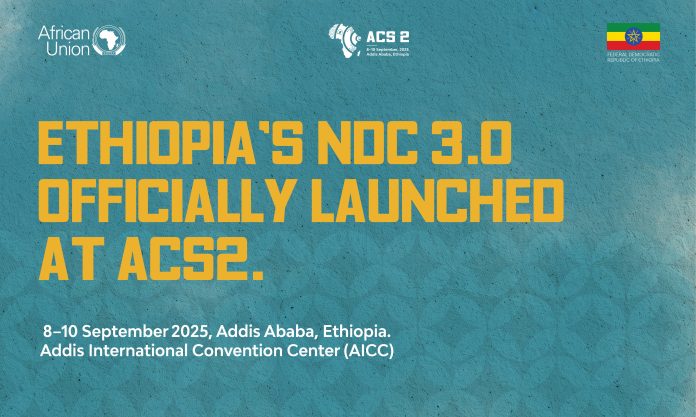Ethiopia used the Second Africa Climate Summit in Addis Ababa to publish its third-generation Nationally Determined Contribution (NDC 3.0), framing a ten-year climate plan that runs from 2025 to 2035 and pairs stepped-up emissions targets with explicit domestic financing commitments and appeals for international support. The update raises the country’s conditional mitigation ambition to a 70.3 percent reduction in greenhouse gas emissions by 2035 against a business-as-usual baseline, while retaining an unconditional pledge of a 30.7 percent cut, and presents a financing envelope that the government says includes USD 22.13 billion in domestic mobilization.
The new NDC builds on Ethiopia’s earlier climate strategies and situates mitigation alongside adaptation, resilience and equitable transitions. The plan increases the conditional target slightly from the previous submission and adds more detail on sectoral pathways and implementation milestones, reflecting the government’s longer-term low-emission development pathway and a desire to align national policy with international expectations for measurable progress. The document signals that achieving the conditional target depends on significant external finance, technology transfer and capacity support, a theme Ethiopia reiterated at the pavilion launch.
Policy designers in Addis Ababa anchored much of the NDC’s plausibility in the state’s recent investments in energy and land use. The Green Legacy reforestation drive and other forestry measures are presented as elements that expand carbon sinks while offering co-benefits for erosion control and local livelihoods; the country’s long-term low-emissions strategy provides the policy scaffolding tying these measures to national development plans. At the same time, the government highlighted its expanded hydropower capacity, most visibly the Grand Ethiopian Renaissance Dam, which it expects to multiply clean power availability and underpin industrialization and regional power exports. These infrastructure gains strengthen the emissions-reduction case, though they also come with geopolitical and operational risks that will shape implementation.
The timing of Ethiopia’s submission intersects with a wider African push for a revised climate-finance architecture. Delegates at the summit advanced proposals for new continental financing instruments and a target to mobilize substantially larger annual flows for adaptation and green growth, reflecting an emergent consensus that current grant and concession pipelines fall short of national needs. Those proposals include a package of continental initiatives intended to pool public and private capital and channel it toward bankable climate projects; they provide a backdrop to Ethiopia’s appeal for external partners to help bridge the gap between its domestic pledge and full implementation costs.
International organizations and technical partners followed the launch closely, reaffirming that updated NDCs require credible implementation pathways and robust measurement, reporting and verification systems. Ethiopia’s engagement with multilateral development institutions, climate finance facilities and sector partners will determine whether its conditional ambition can be turned into concrete investments in renewables, sustainable agriculture, resilient infrastructure and social protection. The NDC Partnership and other coordination platforms signaled readiness to support planning and project preparation, while noting that scaling pipelines quickly will be essential if the conditional targets are to be achievable.
Read also: ACS2 side events highlighted financing, innovation, and adaptation gaps in Africa’s climate agenda
The policy challenge ahead is operational rather than rhetorical. Translating a high-percentage mitigation figure into emissions outcomes will require sequencing of investments, clear governance for project selection, predictable concessional finance and private capital, and regional cooperation on transboundary resources such as the Blue Nile. Donor commitments at multilateral fora and the ability of African institutions to de-risk investments will shape how much of the conditional ambition becomes reality before 2035. Ethiopia’s NDC 3.0 therefore offers both a statement of intent and a test case for the continent’s broader demand: a financing and technical architecture that matches declared priorities with deliverable projects.
The Ethiopian submission and the summit’s financing proposals merit close attention because they illustrate an emerging model in which national planning, domestic investment and continental financing initiatives are being marshalled together. The coming months will show whether that alignment produces bankable project pipelines, stronger regional cooperation on shared resources, and the institutional reforms necessary to convert targets into emissions reductions and resilience outcomes.






